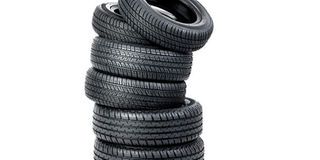How well do you know your tyres?

Tyres
Tyres look simple but are a complex mixture of various components. Being the contact point between the car body and the ground, they are built to withstand the stresses that come with the “job”.
Though they incorporate several compounds, in some cases, more than 60, depending on the specific purpose and vehicle for which it is made.
However, despite the different makes, sizes and uses, tyres have a universal purposes.
Tyres are made to withstand pressure and also complete the car by enabling motion.
They support the load of the vehicle due to the compressed air in them.
Going forward, tyres help the car in steering and changing direction.
This is mainly through transmission of the driving force from mechanical in to motion.
Tyres also maintain the vehicle on the road, through stopping by generating a traction force.
Types and uses
It is worth noting that there are specifications meant for particular tyres.
It is thus recommended that drivers should know the type of roads on which he or she will be driving and frequeny of using the vehicles over these roads.
This helps determine the type of tyres he or she will need. Peter Amadi, from Dalas Auto Garage, explains: “Determine whether the tyres are mud grip or ordinary before purchasing them plus the tyre pattern. All these factors are key when ordering for tyres.”
This is echoed by Fredrick Mwaluko, the head technical at City Tyres. He points out that car makers dictate the rim size and type of tyres for the car. “These specifications are found on the right hand side for Japanese made vehicles and on the lid for the fuel tank, for the German makes.”
For the conventional type of car, for example, a Toyota Premio, universal tyres are usually used. But, for light trucks, four-wheel or all-wheel drive cars and high performance cars, the specifications will differ.
Vital information
Most tyres come with these details marked on them. For example, you may find these such markings: 185/70/R14.
Mwaluko explains that 185 represents the section width measured in millimetres, 70 represents the profile, also known as the aspect ratio (the ration of the height to the width, R represents the construction of the tyre, either radial or diagonal, and 14 represents the rim diametre, given in inches.
Also, most tyres come with the load index which indicates the maximum load that the tyre can carry. “The index differs for trucks and passenger vehicles,” he adds, saying that each tyre comes with a speed rate indicating the maximum speed that each tyre can move at.
“High speed or low speed tyres, all these can be determined by visiting a tyre expert or specialised tyre centre,” advises Amadi.
All these specification are also complemented by the treads on the tyres. These differ according to the application of the tyre. For the passenger service car, like the saloon cars, the tyre treads are usually radial.
The terms “radial” and “diagonal” refer to the pattern and arrangement of the components that make the tyre. Each has its pros and cons.
A tyre has a lifespan of five years from the date of manufacture. This is also on the tyre wall and is a four digit number. The first two represent the week of manufacture and the last two indicate the year.
Care and maintenance
To get the best out of your tyre, car owners are advised to regularly maintain their tyres. There are several factors that they are advised to guard against.
Any tyre, no matter how well constructed, may fail in use as a result of punctures, impact damage, improper inflation, overloading, excessive wear or other use conditions.
To reduce the risk of tyre failure, Mwaluko advises the driver to check the air pressure in all tyres, including the spare, frequently when tyres are cool. Note that tyres to heat up when the car has been drived for a distance.
A tyre is wear-sensitive and all tyres eventually wear out. A worn or damaged tyre can present a safety hazard, and a tyre failure can lead to an accident that will result in damage, injuries or death.
Amadi sums up it, “Ensure regular wheel balancing and alignment to prevent wear and tear. Ensure rotation of the tyres very six months.”
Tips to note about your car tyres
Keep your tyres properly inflated.
Tyre age is dated from the date of manufacture, not sale, as tires deteriorate even in storage.
Test all of your tyres and if possible, replace them all at the same time. Mismatched tyres will not provide the same safety, performance and efficiency as a matched pair will.
Treadwear grades are an indication of a tire’s relative wear rate. The higher the treadwear number is, the longer it should take for the tread to wear down.
On four-wheel-drive or all-wheel-drive cars you should replace all four tires if it is recommended in your service manual. Differences in tire diameter, even due to different states of tread wear, can permanently damage differentials.
Tyres do not wear perfectly evenly, so be sure to insert the coin at several points from the outside to the inside of your tires. Tyres generally wear more on the inside but over-inflated tires will wear more in the middle.
If you see uneven wear on a front tyre, chances are that the front end is out of alignment.
You should have this checked and rotate the tyres to the rear if possible (some vehicles have different sizes on front than the rear). The tyres from the back should be fine and the uneven tires moved to the rear will start to correct themselves.
Tyres age faster in warmer climates.
Source: wikihow.com




